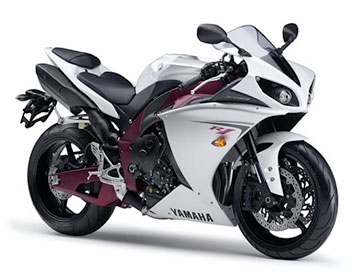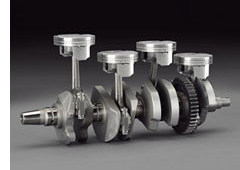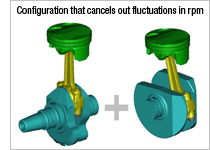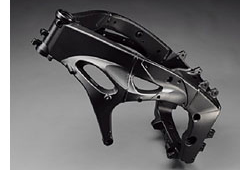Yamaha Motor Co., Ltd. announces the development of the new YZF-R1 model featuring a new 1,000cc liquid-cooled 4-stroke in-line-4, fuel injected engine and packed with the latest technology from the YZR-M1 MotoGP machine. This new YZF-R1 will be released as the 2009 European market model from January 2009.
The 2009 model YZF-R1 is the 6th generation model since its original release in 1998. In the development of the new YZF-R1, a full re-designing of the engine and chassis under the product concept of an "Ultimate Cornering Master 1000." In particular, the new engine adopting a "crossplane crankshaft" based on technology from Yamaha's road racer YZR-M1 competing in the pinnacle MotoGP class of international motorcycle racing achieves more linear traction characteristics for outstanding cornering performance.
This combines with newly designed frame and other components, these features let the rider experience a new level of sportier ride through all stages of cornering: entering the turn, leaning the machine and exiting the turn. |
 |
2009 European market model YZF-R1 |
Name: |
YZF-R1 |
Release date: |
January 2009 |
Coloring: |
- Black Metallic X
- Bluish White Cocktail 1
- Dark Purplish Blue Metallic C |

1) 1,000cc engine with newly designed crossplane crankshaft
To help achieve outstanding cornering performance, a new 1,000cc liquid-cooled, in-line 4-cylinder, 4-valve DOHC engine with a crossplane crankshaft has been developed. For the bore x stroke, this new engine adopts a short stroke type spec with the largest bore ever for a Yamaha 1,000cc supersport model at 78 x 52.2 mm.
This crossplane crankshaft has been developed with technology from Yamaha's YZR-M1 MotoGP race machine. It helps achieve more linear drive power in response to the rider's throttle work, which means more linear controllability when exiting a corner from a deep lean. The result is outstanding cornering performance and acceleration out of the curves.
|
 * The crossplane crankshaft
This is a crankshaft configuration engineered to bring out high-quality torque characteristics from a high-revving type engine.
<Explanation>
The inertial force of the piston causes a slight variation in the revolving speed of the crankshaft during the course of each revolution. The fact that the two inside cylinders and the two outside cylinders move in unison on a conventional in-line 4cylinder engine, this revolving speed variant is augmented, producing a four times greater variant in rpm. The crossplane crankshaft is designed to cancel out this torque variant by setting the interval between neighboring pistons at 1/4th of a revolution (90 degrees) so that the fluctuations in crank speed are canceled out. This in turn creates high-quality torque characteristics in a high-revving type engine.
2) Large 36mm diameter crank journal
The new engine features a large 36mm diameter crank journal (compared to 32 mm on existing model), and its relationship with other specs, including the lightweight forged aluminum piston, the closed deck type combustion chamber, the FS connecting rods, the new-design crank wave and the ACM, have all been balanced to achieve optimum inertial moment for the crankshaft (increased by approx. 20% compared to the existing model). This combines with the twin-injector type fuel injection system, the Yamaha Chip Controlled Intake (YCC-I) and Yamaha Chip Controlled Throttle (YCC-T) to produce outstanding engine response characteristics.
3) Newly designed aluminum frame
 To achieve outstanding handling performance, a newly designed aluminum Deltabox frame is adopted. The same layout as the existing model that enables the duct from the air induction port to run through the frame is adopted, but the shape and size, the types of aluminum used and the overall rigidity balance have all been newly designed, primarily to accommodate new engine mount positions. The optimized rigidity balance contributes not only to high-speed stability but also helps improve handling, especially in terms of enabling effective traction when exiting a curve. To achieve outstanding handling performance, a newly designed aluminum Deltabox frame is adopted. The same layout as the existing model that enables the duct from the air induction port to run through the frame is adopted, but the shape and size, the types of aluminum used and the overall rigidity balance have all been newly designed, primarily to accommodate new engine mount positions. The optimized rigidity balance contributes not only to high-speed stability but also helps improve handling, especially in terms of enabling effective traction when exiting a curve.
The dimensions have also been optimized. Compared to the existing model the engine mounting angle is nine degrees more upright at a 31-degree forward incline of the cylinders and the engine mounting position is 12mm farther forward in terms of its relationship to the drive axis in order to contribute to an even better feeling of front wheel road contact. Also, the pivot position is optimized so that the chain tension during acceleration effectively produces rear suspension stroke and thus contributes to good transfer of drive force to the road surface.
4) Magnesium rear frame
The rear frame is made of magnesium, with its high strength to weight ratio. Because the rear frame is a component located far from the machine's center of balance, this weight reduction contributes significantly to increasing concentration of mass. A magnesium rear frame has already proven effective on the 2008 model YZF-R6 and is manufactured by Yamaha's exclusive "CF Magnesium Die Casting Technology."
5) Front fork with left-right independent cushioning mechanisms
An inverted front fork with 43mm inner tubes (same size as the existing unit) is adopted. A new feature of this fork is that it has left-right independent cushioning mechanisms. Compression stroke damping force is created on the left side and rebound damping force on the right side of the fork. This makes it possible to optimize the flow of the fluid that generates the damping force with a high degree of accuracy and minimize cavitation occurring during successive strokes, thus contributing to more stable performance. At the same time, the diameter of the internal cylinder has been increased to stabilize pressure variance and ensure sufficient oil volume to enable the shock absorber to respond quickly with damping force for even the smallest stroke movements and thus provide outstanding road hold.
6) New-shape fuel tank that contributes to concentration of mass
A fuel tank with a shape that was developed using 3-D simulation analysis technology is adopted. With an 18-liter capacity and added vertical height that allows it to fit neatly within the frame, this new tank contributes to increased concentration of mass. This minimizes the variance in riding feeling as the amount of fuel in the tank decreases.
7) New styling expressing concentration of mass and compactness
The body is sculpted with a new styling that embodies concentration of mass and high-density compactness while also using the rear tire as a focal point to give visual expression to the dynamic traction characteristics achieved by the new engine. This combines with the shorter design of the muffler to express and image of strong drive traction with the rear tire as the main point of focus and a sense of minimalism and front-rear concentration of power. Another thing that distinguishes the body styling is the simple but bold use of surfaces on the middle cowl. This is a sculptural design based on the concept of giving visual expression to a layered type of structure that creates a sense of two layers of motion: the motion of air across the outer surfaces of the machine and the motion of air through the inside of the cowling. This is a straight expression of the two roles of the middle cowling, to achieve outstanding aerodynamic characteristics and rider wind protection when running at high speeds and the air management function for the purpose of heat dissipation by the cooling system.
8) Other features
Other features include 1) a 3-mode control map selection function (YAMAHA D-MODE). 2) a slipper clutch, 3) a 4-2-1-2 exhaust pipe and twin mufflers, 4) a shock absorber with "2-way adjuster function" for the compression-side damping and 5) projector type headlights with solenoid driven Hi - Lo selector, and more. |
| Overall length x width x height |
2,070mm x 715mm x 1,130mm |
| Seat height |
835mm |
| Wheelbase |
1,415mm |
| Wet weight (with oil and full fuel tank) |
206kg |
| Engine type |
Liquid cooled, 4-stroke, DOHC, 4-valve |
| Cylinder arrangement |
Forward-inclined parallel 4-cylinder |
| Displacement |
998cm3 |
| Bore & stroke |
78.0mm x 52.2mm |
| Compression ratio |
12.7:1 |
| Maximum horse power |
133.9kW (182PS) / 12,500r/min |
| Maximum torque |
115.5N•m (11.8kgf•m) / 10,000r/min |
| Starting system type |
Electric starter |
| Fuel tank capacity |
18 L |
| Fuel supply |
FI |
| Tire sizes (front/rear) |
120/70ZR17M/C (58W) / 190/55ZR17M/C (75W) |
|